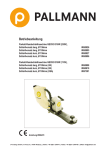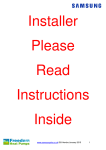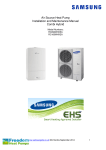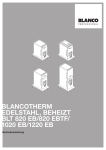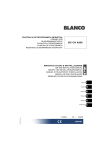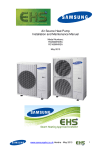Download WOLFF 054720 Operating instructions
Transcript
WOLFF | A Brand of UFLOOR Systems Operating instructions Parquet sanding machine Cobra 2.5 kW(3,2kW)/50 Hz Item no. 052549 + 052551 + 054720 + 054891 Item no. 054004 WOLFF | A Brand of UFLOOR Systems | 71665 Vaihingen/Enz | Dieselstraße 19 | Tel. +49 (0)70 42 95 11- 0 | Fax +49 (0)70 42 95 11- 44 | E-mail [email protected] | Internet www.wolff-tools.de © 2009 All rights reserved. Reproduction in whole or in parts requires written permission from Hermann FRANK GmbH & Co. KG, 75038 Oberderdingen, Germany. No liability for any damage arising from the use of this brochure. Subject to alterations. Hermann FRANK GmbH & Co. KG Östliche Bahnhofstr. 8 75038 Oberderdingen Germany Tel.: +49 (0)72 58 / 60 88-0 Fax: +49 (0)72 58 / 60 88-11 E-mail: [email protected] www.hermannfrank.de As of: March 2009 2 03/2009 This brochure uses the following symbol to mark important instructions for safety and preventing damage: Please give special attention to the marked instructions. They refer to a potentially dangerous situation. Failure to comply can result in fatal or severe injuries and damage to property. 3 03/2009 Contents 1 Introduction . . . . . . . . . . . . . . . . . . . . . . . . . . . . . . . . . . . . . . . . . . . . . . . . . . . . . . . . . . . . . . . . . . . . . . . .5 2 Scope of delivery . . . . . . . . . . . . . . . . . . . . . . . . . . . . . . . . . . . . . . . . . . . . . . . . . . . . . . . . . . . . . . . . . . . .6 3 Description of the parquet sanding machine Cobra . . . . . . . . . . . . . . . . . . . . . . . . . . . . . . . . . . . . . . . .7 3.1 3.2 3.3 Important components . . . . . . . . . . . . . . . . . . . . . . . . . . . . . . . . . . . . . . . . . . . . . . . . . . . . . . . . . . . . . . . . . . . . . . . . .7 Technical data . . . . . . . . . . . . . . . . . . . . . . . . . . . . . . . . . . . . . . . . . . . . . . . . . . . . . . . . . . . . . . . . . . . . . . . . . . . . . . .8 Safety and machine protection devices . . . . . . . . . . . . . . . . . . . . . . . . . . . . . . . . . . . . . . . . . . . . . . . . . . . . . . . . . . . .8 4 Proper use . . . . . . . . . . . . . . . . . . . . . . . . . . . . . . . . . . . . . . . . . . . . . . . . . . . . . . . . . . . . . . . . . . . . . . . . .8 5 Starting the machine . . . . . . . . . . . . . . . . . . . . . . . . . . . . . . . . . . . . . . . . . . . . . . . . . . . . . . . . . . . . . . . . .9 5.1 5.2 5.3 5.4 5.5 5.6 5.7 Mounting the handle . . . . . . . . . . . . . . . . . . . . . . . . . . . . . . . . . . . . . . . . . . . . . . . . . . . . . . . . . . . . . . . . . . . . . . . . . .9 Mounting the dust pipe . . . . . . . . . . . . . . . . . . . . . . . . . . . . . . . . . . . . . . . . . . . . . . . . . . . . . . . . . . . . . . . . . . . . . . . .10 Mounting the motor . . . . . . . . . . . . . . . . . . . . . . . . . . . . . . . . . . . . . . . . . . . . . . . . . . . . . . . . . . . . . . . . . . . . . . . . . . .11 Mounting the belt . . . . . . . . . . . . . . . . . . . . . . . . . . . . . . . . . . . . . . . . . . . . . . . . . . . . . . . . . . . . . . . . . . . . . . . . . . . .12 Mounting the dust bag . . . . . . . . . . . . . . . . . . . . . . . . . . . . . . . . . . . . . . . . . . . . . . . . . . . . . . . . . . . . . . . . . . . . . . . .13 Adjusting the wall bumper wheels . . . . . . . . . . . . . . . . . . . . . . . . . . . . . . . . . . . . . . . . . . . . . . . . . . . . . . . . . . . . . . . .14 Connecting the Cobra to the mains supply . . . . . . . . . . . . . . . . . . . . . . . . . . . . . . . . . . . . . . . . . . . . . . . . . . . . . . . . .15 6 Disassembling for transportation . . . . . . . . . . . . . . . . . . . . . . . . . . . . . . . . . . . . . . . . . . . . . . . . . . . . .16 6.1 6.2 6.3 Removing the handle . . . . . . . . . . . . . . . . . . . . . . . . . . . . . . . . . . . . . . . . . . . . . . . . . . . . . . . . . . . . . . . . . . . . . . . . .16 Removing the motor . . . . . . . . . . . . . . . . . . . . . . . . . . . . . . . . . . . . . . . . . . . . . . . . . . . . . . . . . . . . . . . . . . . . . . . . . .17 Transporting the machine . . . . . . . . . . . . . . . . . . . . . . . . . . . . . . . . . . . . . . . . . . . . . . . . . . . . . . . . . . . . . . . . . . . . . .18 7 Operating the Cobra . . . . . . . . . . . . . . . . . . . . . . . . . . . . . . . . . . . . . . . . . . . . . . . . . . . . . . . . . . . . . . . .19 7.1 7.2 7.3 7.4 7.5 7.6 7.7 7.8 7.9 Proper clothing and equipment . . . . . . . . . . . . . . . . . . . . . . . . . . . . . . . . . . . . . . . . . . . . . . . . . . . . . . . . . . . . . . . . .19 Safety instructions regarding dust . . . . . . . . . . . . . . . . . . . . . . . . . . . . . . . . . . . . . . . . . . . . . . . . . . . . . . . . . . . . . . . .20 Disposal of sanding dust . . . . . . . . . . . . . . . . . . . . . . . . . . . . . . . . . . . . . . . . . . . . . . . . . . . . . . . . . . . . . . . . . . . . . . .21 Replacing the abrasive belt . . . . . . . . . . . . . . . . . . . . . . . . . . . . . . . . . . . . . . . . . . . . . . . . . . . . . . . . . . . . . . . . . . . . .22 Adjusting the sanding pressure . . . . . . . . . . . . . . . . . . . . . . . . . . . . . . . . . . . . . . . . . . . . . . . . . . . . . . . . . . . . . . . . . .23 Safety instructions for electric cable and connectors . . . . . . . . . . . . . . . . . . . . . . . . . . . . . . . . . . . . . . . . . . . . . . . . .24 Remarks about sanding woodfloor and floorboard floors . . . . . . . . . . . . . . . . . . . . . . . . . . . . . . . . . . . . . . . . . . . . . .25 Switching on/off the Cobra with the cockpit control panel . . . . . . . . . . . . . . . . . . . . . . . . . . . . . . . . . . . . . . . . . . . . . .28 Sanding with the Cobra . . . . . . . . . . . . . . . . . . . . . . . . . . . . . . . . . . . . . . . . . . . . . . . . . . . . . . . . . . . . . . . . . . . . . . . .29 8 Maintenance . . . . . . . . . . . . . . . . . . . . . . . . . . . . . . . . . . . . . . . . . . . . . . . . . . . . . . . . . . . . . . . . . . . . . . .34 8.1 8.2 8.3 8.4 8.5 Replacing the sanding roller . . . . . . . . . . . . . . . . . . . . . . . . . . . . . . . . . . . . . . . . . . . . . . . . . . . . . . . . . . . . . . . . . . . .34 Adjusting the running wheels . . . . . . . . . . . . . . . . . . . . . . . . . . . . . . . . . . . . . . . . . . . . . . . . . . . . . . . . . . . . . . . . . . .36 Adjusting the castors . . . . . . . . . . . . . . . . . . . . . . . . . . . . . . . . . . . . . . . . . . . . . . . . . . . . . . . . . . . . . . . . . . . . . . . . . .37 Adjusting the tension roller . . . . . . . . . . . . . . . . . . . . . . . . . . . . . . . . . . . . . . . . . . . . . . . . . . . . . . . . . . . . . . . . . . . . .38 Replacing the lamp . . . . . . . . . . . . . . . . . . . . . . . . . . . . . . . . . . . . . . . . . . . . . . . . . . . . . . . . . . . . . . . . . . . . . . . . . . .39 9. Declaration of conformity . . . . . . . . . . . . . . . . . . . . . . . . . . . . . . . . . . . . . . . . . . . . . . . . . . . . . . . . . . . .39 10. Warranty . . . . . . . . . . . . . . . . . . . . . . . . . . . . . . . . . . . . . . . . . . . . . . . . . . . . . . . . . . . . . . . . . . . . . . . . . .40 4 03/2009 1 Introduction Dear customer: Congratulations on purchasing the FRANK parquet sanding machine Cobra, the correct choice with respect to quality and performance. The Cobra is the result of a consistent implementation of many years of experience. This machine combines extraordinary high sanding performance and excellent sanding quality with easy to operate, proven and reliable technology. These operating instructions contain important information for the use and safe operation of the Cobra. Caution! Read these operating instructions carefully before assembling or operating the Cobra. Ensure that all operators read these instructions before they use the machine. Adherence to the safety notes helps to avoid potential danger of life and limb. It also prevents improper use of the machine. Before starting to work, make yourself familiar with the operation of the machine. It’s too late if you do it while working! Never allow anybody to operate the machine without sufficient skills and knowledge. 5 03/2009 2 Scope of delivery 1 1. Machine 2. PUR cable with plug and coupling 3. Dust mask 4. Operating instructions 5. Allen keys 5 mm, 6 mm, 10 mm 6. Running wheel adjustment gauge 7. Tool bag 8. Fixed spanners 10 mm, 13 mm, 17 mm, 30/36 mm 9. Hearing protection Not shown: 2 dust bags Not shown: Abrasive belts (10 pcs. each with grit 36, grit 60, grit 100) Not shown: 10 plastic inlays 6 03/2009 3 Description of the parquet sanding machine Cobra 3.1 Important components 14 11 6 15 16 12 10 1 13 9 4 1 Sanding pressure regulator 7 8 7 3 5 2 9 Belt cover 2 Castors 10 Motor 3 Running wheels 11 Cockpit 4 Roller cover 12 Cable arm 5 Star-shaped knob 13 Rear carrying bar 6 Motor plug 14 Main lifting lever 7 Front carrying bar 15 Soft lowering lever 8 Wall bumper wheel 16 Hood 03/2009 3.2 Technical data Single-phase AC motor . . . . . . . . . . . . . . . . . . . . 230 V (240 V), 50 Hz Motor capacity . . . . . . . . . . . . . . . . . . . . . . . . . . . . . . . 2.5 kW (3,2 kW) Roller speed . . . . . . . . . . . . . . . . . . . . . . . . . . . . . . . . . . . . . 2,100 rpm Sanding width . . . . . . . . . . . . . . . . . . . . . . . . . . . . . . . . . . . . . . 200 mm Abrasive belt dimensions. . . . . . . . . . . . . . 200 mm x 750 mm, endless Weight: Handle compl. . . . . . . . . . . . . . . . . . . . . . . . . . . . . 12,8 kg Motor compl. . . . . . . . . . . . . . . . . . . . . . . . . . . . . . 26,2 kg Basic unit compl. . . . . . . . . . . . . . . . . . . . . . . . . . . 49,2 kg Dust pipe . . . . . . . . . . . . . . . . . . . . . . . . . . . . . . . . . 1,5 kg Machine compl. . . . . . . . . . . . . . . . . . . . . . . . . . . . 89,7 kg 3.3 Safety and machine protection devices The parquet sanding machine Cobra is equipped with a - zero voltage switch. The zero voltage switch switches off the machine in case of power failure and the motor will not restart automatically when power returns. 4 Proper use The parquet sanding machine Cobra is suitable for dry sanding of woodfloor and floorboard floors. No other use shall be allowed. Caution! Do not use the Cobra for wet finishing (danger of death from electric shock)! 8 03/2009 5 Starting the machine 5.1 Mounting the handle Note! The Cobra is delivered with handle and dust pipe dismantled. Caution! There is the risk of injury or damage caused by an unintentional starting of the machine. Disconnect the machine from the mains supply before working on the machine! 5 3 6 1 4 2 1 How to mount the handle: 1. Insert the bottom part of the connecting rod through the slot of the handle mount. Make sure that the fixing studs ( 1 ) are inserted into the positioning holes ( 2 ). 2. Tighten the star-shaped knob ( 3 ). 3. Check the position number of the handle. 4. Insert the stud ( 4 ) on the rod into the corresponding hole ( 5 ). 5. The clamp sleeve ( 6 ) firmly fixes the two parts of the connecting rod. 9 03/2009 5.1.1 Adjusting the handle height 1. Lower the main lifting lever ( 1 ) to the front. 2. Slide the clamp sleeve ( 2 ) to the top and take apart the connecting rod ( 3 ). 3. Loosen the clamp bolt ( 4 ). 4. Pull the locking stud ( 5 ) and have it snapped in at the desired position. 5. Assemble the connecting rod ( 3 ) on this position. 1 5 4 3 2 5.2 Mounting the dust pipe 1 2 Insert the dust pipe ( 1 ) into the pipe connection ( 2 ) while gently rotating it. It is sealed with 2 O-rings. 10 03/2009 5.3 Mounting the motor The machine is delivered with the motor already mounted. Due to reasons of weight, it may however be necessary to remove the motor to transport the machine (see chapter 6.2, Removing the motor, on page 17). Before placing the motor onto the machine, make sure the catch ( 1 ) is in the open position. When the motor is placed correctly, lock the catch ( 1 ) to fix the motor. 1 1 1 1 11 03/2009 5.4 Installing the belt 1. Swing out the lever ( 4 ) and lift the belt tensioner ( 2 ) until the locking stud ( 3 ) unlatches. 2. Insert the belt ( 1 ) around the belt pulleys and deflection roller as shown in the figure. 3. Slightly lift the belt tensioner ( 2 ) and pull back the locking stud ( 3 ). 4. Lower the belt tensioner to take up belt slack. 5. Pull the lever ( 4 ) and fold it in. 1 1 2 4 3 12 03/2009 5.5 Mounting the dust bag Caution! Only use original FRANK dust bags for the parquet floor sanding machine Cobra. Caution! Make sure the dust bag is fitted securely to the dust pipe before sanding. How to install the dust bag: 1. Pull the outer bag over the dust pipe behind the pipe reinforcement ( 1 ). Lace up the cords carefully. 2. Open the zipper of the dust bag. Insert the disposable inlay into the outer bag and tighten it around the dust pipe ring ( 2 ). Lace up the inlay bag. 3. Close the zipper. 1 1 2 2 13 03/2009 5.6 Adjusting the wall bumper wheels 1 1 1. Loosen the bolts ( 1 ) to slacken the mounts. 2. The wheels can be screwed in or out by rotating them to adjust them to the proper wall distance. The wheels must be positioned horizontally to the floor. 3. After adjusting the wheels tighten the bolts again. 14 03/2009 5.7 Connecting the Cobra to the mains supply How to connect the machine to the mains supply: 1. Make sure that the switch ( 1 ) is in the off position. The machine must be switched off before connecting it to the mains supply. 2. The main lifting lever for the sanding roller ( 2 ) must be folded backward so that the sanding roller is raised from the floor. 3. Hang the pivoting cable arm into the left or right cable arm bracket as required. Wind the power cable through the curls at the end of the cable arm ( 3 ) to keep the cable away from the sanding zone. 4. Connect the motor coupling ( 4 ) of the control cable to the motor. 5. Connect the coupling ( 5 ) of the lamp cable to the plug ( 5 ). 1 4 2 5 3 Caution! Make sure that the abrasive belt is tight before you switch on the motor. Caution! Make sure that the sanding roller is raised from the floor before you switch on the motor. Caution! Risk of injury if the machine starts unintentionally! Disconnect the machine from the mains supply when not in use, when changing the abrasive belt, or when carrying out service work on the machine. 15 03/2009 6 Disassembling for transportation For easier transportation, the handle, the dust pipe, and the motor can be removed. 6.1 Removing the handle There is the risk of injury or damage caused by an unintentional starting of the machine. Disconnect the machine from the mains supply before working on the machine! How to remove the handle: 1. Disconnect the motor and lamp couplings. 2. Fold down the cable arm ( 1 ). 3. Fold the main lifting lever ( 2 ) to the front position to lower the sanding roller to the floor. This removes load from the connecting rod ( 3 ). 4. Slide the clamp sleeve ( 4 ) to the top and take apart the two halves of the connecting rod ( 3 ). 5. Remove the star-shaped knob ( 5 ), and you can lift off the handle. 2 1 3 4 5 16 03/2009 6.2 Removing the motor There is the risk of injury or damage caused by an unintentional starting of the machine. Disconnect the machine from the mains supply before working on the machine! How to remove the motor: 1. Make sure that the motor switch is in the off position and that the power cable is disconnected from the motor plug. 2. Unscrew the bolt ( 1 ) from the belt cover and open the cover. 3. Slacken the belt by raising the belt tensioner ( 2 ) until the locking stud ( 3 ) unlatches. 4. Remove the belt. 6. Open the catch ( 4 ) on the motor base. 7. You can lift off the motor. 8. See chapter 5.3, page 11 on how to mount the motor. 3 1 2 4 17 03/2009 6.3 Transporting the machine To carry the machine, use the two carrying bars at the front ( 1 ) and back ( 2 ). The front carrying bar ( 1 ) can be folded up. The transport plate is recommended for transporting the machine. When the machine is placed on the transport plate, the sanding roller and the castors are unloaded. Accessory: Transport plate, item no. 051224 1 Transport plate 2 1 18 03/2009 7 Operating the Cobra 7.1 Proper clothing and equipment Caution! Wear hearing protectors! Wear hearing protection when operating the parquet sanding machine Cobra. Wear the ear muffs supplied as accessory with the machine. The following sound level values were measured for the parquet sanding machine Cobra according to DIN 45645: Idle mode LEQ = 84 dB (A) Working mode LEQ = 85 dB (A) The noise which the machine emits when working depends on various factors. Local conditions such as room size and quality of the floor affect noise emission. Caution! Wear dust mask! Wear a dust mask when operating the parquet sanding machine Cobra or when disposing of the sanding dust (see chapter 7.2 and 7.3). Wear the dust mask supplied as accessory with the machine. Caution! Wear protective goggles! Wear protective goggles to protect your eyes when operating the parquet sanding machine Cobra or carrying out any work on the machine. Caution! Wear proper work clothes! Do not wear loose clothes when operating the parquet sanding machine Cobra or carrying out any work on the machine. The clothes might get caught in moving parts. 19 03/2009 7.2 Safety instructions regarding dust Caution! Ultra-fine sanding dust! Wear a dust mask when sanding woodfloor or floorboard flooring. A dust mask is supplied as accessory with the machine. When the machine is used for its proper purpose, the sanding of wooden floors naturally produces dust. The machine is equipped with an integrated dust absorption system to blow the dust into the dust bag. The dust is collected in the dust bag. Nevertheless, the system cannot prevent the release of fine and ultra-fine dust. Caution! Health hazard! Wood dust, particularly when treated with impregnating agents, solvents or coatings, can cause allergic reactions (e.g. of the skin or respiratory system) after an allergisation period. Beechwood and oakwood dust is classified as carcinogenic (nasal mucosa cancer). Dust from other types of wood is suspected of having carcinogenic effects. Caution! Risk of fire! No smoking! Do not smoke while sanding! Ignition sources are prohibited in rooms where sanding work is being carried out! Air the rooms thoroughly. In combination of an ignition source and the oxygen in the air, wood dust can cause fires and explosions. Caution! Risk of fire! Sanding over metal parts, like e.g. nails, can produce sparks which are blown into the dust bag together with the wood dust. Glowing metal chips can ignite a fire in the dust bag even hours later. Every time the machine is stopped or after completing work, immediately empty the sanding dust in the dust bag to a fireproof, non-flammable container. The container must be covered with a fireproof, non-flammable lid. Store the container only outdoors. 20 03/2009 7.3 Disposal of sanding dust Caution! Risk of fire! Because of the fire risk, the sanding dust contained in the dust bag must always be disposed of immediately every time the machine stops or when sanding is completed. The sanding dust must be disposed of in a fireproof, non-flammable container. The container must be covered with a fireproof, non-flammable lid. Store the container only outdoors. Caution! When a third of the dust bag is filled with sanding dust at the latest, empty the dust bag. Otherwise, the dust absorption performance of the machine will deteriorate. The sanding dust must be disposed of in a fireproof, non-flammable container. The container must be covered with a fireproof, non-flammable lid. Store the container only outdoors. Caution! Always wear a dust mask when disposing of the sanding dust. A dust mask is supplied as accessory with the machine. 21 03/2009 7.4 Replacing the abrasive belt Caution! Risk of injury if the machine starts unintentionally! When replacing the abrasive belt, there is a risk of starting the machine unintentionally. Unplug the machine from the mains supply before working on the abrasive belt. Caution! Risk of cutting your hands! The sanding grains of the abrasive belt have sharp edges. Always wear safety gloves when replacing the abrasive belt. How to replace the abrasive belt: 1. Switch off the machine. 2. Unplug the power cable from the mains supply. 3. Open the roller cover ( 1 ) and the hood ( 2 ). 4. Fold the tension lever ( 3 ) to the front. The tension of the abrasive belt ( 4 ) will be slackened. Pull it out to the side. 5. Insert a new abrasive belt. Pay attention to the rotating direction of the sanding roller ( 5 ) and the abrasive belt ( 4 ). 6. Fold the tension lever ( 3 ) to the back to take up slack of the new abrasive belt. 7. Close the roller cover ( 1 ) and the hood ( 2 ). 3 2 1 22 4 03/2009 7.5 Adjusting the sanding pressure Use the sanding pressure regulator ( 1 ) to adjust the required sanding pressure. 1. Fold the main lifting lever ( 2 ) to the top. 2. Pull the sanding pressure regulator ( 1 ) to the top and rotate it to the desired position ( 3 ). 3. Release it on the desired position. You can select between 4 levels: Level 1: Easy Level 2: Medium Level 3: Strong Level 4: Extremely strong: Only in perfect conditions: very good power supply, high-quality abrasive belt 2 1 3 23 03/2009 7.6 Safety instructions for electric cable and connectors Caution! Danger of death from electric shock! Danger of death from electric shock if the electric cable or connectors are damaged. Damaged cables or connectors have to be replaced by a qualified electrician. Caution! Danger of death from electric shock! Danger of death from electric shock when running over the electric cable with the sanding machine! Never point the machine towards the cable! 24 03/2009 7.7 Remarks about sanding woodfloor and floorboard floors Caution! Check the floor for loose boards. They must be fastened before sanding. Caution! Risk of fire! If the floor is installed with nails, make sure that they are countersunk deep enough to avoid a grinding of the nails before you start sanding. Hitting a nail while sanding may produce sparks and cause a fire. A spark in the dust bag, for example, can cause a fire. Floors are sanded in sanding lanes which overlap each other from left to right. 25 03/2009 Each sanding lane corresponds to one forward and one backward sanding without offsetting the backward sanding lane. 26 03/2009 Due to the space needed for the machine operator and the machine itself, the area of approximately 1.5 m to the wall behind the sander will not be sanded. Turn the machine 180° and sand the remaining area of the floor. Again sand in overlapping lanes from left to right. Pay attention to a shoulderfree transition to the area already sanded. Note! To obtain a nice surface of the floor, several sanding rounds are required in general. For detailed information about the proper abrasive grit, sanding pressure and sanding direction for the individual sanding rounds, please refer to our brochure: Sanding parquet and plank floors with the FRANK parquet floor sander COBRA and the FRANK edge sander GECKO S 27 03/2009 7.8 Switching on/off the Cobra with the cockpit control panel 1. Before starting the machine, make sure that the main lifting lever for the sanding roller ( 1 ) is in the rear position. The sanding roller is clearly raised from the floor. The distance to the floor is about 15 mm. The voltmeter ( 5 ) indicates the existing voltage. 2. Before starting the machine, make sure that the abrasive belt is tightened. 3. Turn the switch ( 4 ) to level 1. When the motor has ramped up, switch to level 2. The gradual ramp-up procedure avoids high start-up currents. 4. With cold temperatures (below 10 °C), the motor needs a distinctly longer ramp-up period. Cold bearings have a greater resistance and have to warm up at first. If the motor does not ramp up, let the machine run without abrasive belt for a few minutes. 5. You can use the button ( 2 ) to switch on/off the additional light. 6. The emergency button ( 3 ) triggers the zero voltage switch to interrupt the power supply to the motor. When the emergency button is pressed again, the emergency stop is reset. If the emergency button is pressed during machine operation, the main switch ( 1 ) must be set to 0 before the motor can be started again. 2 4 3 1 5 Caution! At extreme cold temperatures, it may be useful to ramp up the machine without abrasive paper. 28 03/2009 7.9 Sanding with the Cobra 1 1. Before starting the machine, make sure that the main lifting lever for the sanding roller ( 1 ) is in the rear position. The sanding roller is clearly raised from the floor. The distance to the floor is approx. 15 mm. 2. Move the machine to the start position. 29 03/2009 1 2 3. Before you lower the sanding roller to approx. 5 mm above the floor, pull the soft lowering lever ( 2 ) with your right hand and keep it in this position. 4. While holding the soft lowering lever ( 2 ), push the main lifting lever ( 1 ) forward with your left hand. This lowers the sanding roller to approx. 5 mm above the floor. It is absolutely mandatory to keep the soft lowering lever ( 2 ) in the top position. Otherwise, the sanding roller would be lowered onto the floor. 30 03/2009 2 5. To start sanding the first lane, constantly push forward the machine and slowly lower the soft lowering lever ( 2 ) to lower the sanding roller onto the floor. Caution! Move the machine at an even pace while sanding to avoid dents sanded into the floor. 31 03/2009 2 6. Before stopping the machine at the end of the forward movement, pull the soft lowering lever ( 2 ) to lift the sanding roller from the floor. 7. Every forward sanding is followed by a backward sanding in the same lane. For the next forward sanding, offset the machine about 10 cm to the right. Caution! In no event shall the machine come to a standstill while sanding, not even for a short moment as this would sand a dent into the floor. Make sure to always raise the sanding roller while the machine is still in a constant movement before you change directions. Lower the sanding roller only when the machine is in constant movement again. 32 03/2009 1 2 8. How to finish or interrupt a sanding round: To finish or interrupt a sanding round, pull the soft lowering lever ( 2 ) with your right hand and keep it in this position until you moved the main lifting lever ( 1 ) into the rear position with your left hand. Now, you can release the soft lowering lever ( 2 ). Switch off the machine and unplug the cable from the mains supply. Protect the machine against inadvertent rolling away. Caution! The sanding dust contained in the dust bag must be disposed of immediately in a fireproof, non-flammable container. Cover the container with a fireproof, non-flammable lid and store it only outdoors. 33 03/2009 8 Maintenance 8.1 Replacing the sanding roller If the surface of the sanding roller is damaged or worn, the roller must be replaced. How to replace the sanding roller: 2 3 1 4 1. Switch off the machine. 2. Unplug the power cable from the mains supply. 3. Open the roller cover ( 1 ). 4. Fold the tension lever ( 2 ) to the front to slacken the abrasive belt. 5. Pull out the abrasive belt ( 3 ) to the side. 6. Unscrew the retaining nut ( 4 ): The retaining nut is glued to the thread of the sanding roller shaft to avoid an unintentional loosening of the nut while working with the Cobra. To unscrew the retaining nut, use the double-headed fixed spanner delivered with the machine. Lower the sanding roller onto the floor to prevent it from turning while unscrewing the nut. 34 03/2009 7. Lay the machine on its left side. 8. Use a pry bar to gently raise the sanding roller. 9. Take out the sanding roller. 10. Be careful not to loose the parallel key. 11. Slide a new sanding roller onto the sanding roller shaft. The parallel key must properly fit into the slot in the sanding roller shaft. 12. Apply metal adhesive to the retaining nut thread and bolt the nut onto the sanding roller shaft. Securely tighten the retaining nut with the delivered double-headed fixed spanner. Position the machine upright again and lower the sanding roller onto the floor to prevent it from turning while tightening the retaining nut. 13. Fold the main lifting lever back to raise the sanding roller from the floor. 14. Close the roller cover. 15. Protect the machine against inadvertent rolling away. Note! After replacing the sanding roller, the planar setting of the machine has to be readjusted (see chapter 8.2). 35 03/2009 8.2 Adjusting the running wheels If the machine produces a slanted sanding, the planar setting has to be adjusted. After replacing the sanding roller or the running wheels, the planar setting always has to be readjusted. For an exact planar sanding, the sanding roller and the running wheels must be flush. The right running wheel is adjustable. The left wheel does not adjust. 2 3 1 4 How to adjust the running wheels: 1. Switch off the machine. 2. Unplug the power cable from the mains supply. 3. Lay the machine on its left side. 4. Use the running wheel adjustment gauge ( 4 ) to determine the position of the left running wheel ( 1 ). 5. Loosen the lock nut ( 2 ) of the star-shaped knob on the running gear lever behind the right wheel ( 3 ). 36 03/2009 6. Use the running wheel adjustment gauge to adjust the right running wheel ( 3 ) to the position of the left running wheel ( 1 ). Turn the star-shaped knob of the right running wheel ( 3 ) until the right running wheel ( 3 ) slightly touches the bar of the running wheel adjustment gauge ( 4 ). 7. Tighten the lock nut ( 2 ) of the star-shaped knob on the running gear lever beside the right running wheel. 3 4 8.3 1 Adjusting the castors How to adjust the castors: 1 37 1. Switch off the machine. 2. Unplug the power cable from the mains supply. 3. Remove the handle. 4 Loosen the lock nut ( 1 ). 5. Using the Allen key, turn the pivot shaft until both castors touch the floor. 6. Tighten the lock nut. 1 03/2009 8.4 Adjusting the tension roller The tension roller automatically controls the abrasive belt to ensure that the belt runs centrically on the sanding roller. If the automatic centering control deteriorates in the course of operation, the tension roller has to be readjusted. Caution! Danger of injury! The abrasive belt shall only be adjusted by qualified personnel since the adjustment has to be performed on the running machine with opened sanding roller cover (in accordance with BGV A1, § 41 Rüst-, Instandhaltungsarbeiten, German Occupational Health and Safety Association on setting up and maintenance work). Caution! Wear protective goggles and avoid loose clothes when carrying out this adjustment work. How to adjust the tension roller: Caution! Before carrying out the steps described in the following, make sure that the main lifting lever is folded backwards to raise the sanding roller from the floor. 1. Make sure that the motor switch is in the off position and the power cable is unplugged from the mains supply. 2. Open the belt cover. 3. Insert an abrasive belt. 4. Fold the tension lever backwards to take up abrasive belt slack. 2 1 5. 6. 7. 8. Loosen the retaining nut ( 1 ). Connect the machine to the mains supply (see chapter 7.8). Switch on the machine to level 1. Turning the adjustment nuts ( 2 ) moves the tension roller which affects the abrasive belt travel. Adjust the position of the abrasive belt until it runs in the middle of the sanding roller. 9. Switch off the machine and unplug the cable from the mains supply. 10. Tighten the adjustment nuts ( 2 ). 11. Close the belt cover. 38 03/2009 8.5 Replacing the lamp 1. Remove the socket from the lamp ( 3 ) by twisting it a quarter turn to the left. 2. Unscrew the knurled bolt ( 2 ) until you can fold up the clamping bracket ( 1 ). 3. The installation of a new lamp is in reverse order. 3 9. 1 2 Declaration of conformity Herewith, we declare in sole responsibility that this product complies with the following standards and normative documents: EN 50144, in accordance with the regulations of the Directives 73/23/EEC, 89/336/EEC, 98/37/EC. 09 Dipl.-Ing. (FH) Dieter Hammel Design Management p.p. Hermann FRANK GmbH & Co. KG | 75038 Oberderdingen | Östliche Bahnhofstr. 8 39 03/2009 10. Warranty The warranty period for new FRANK machines is one year from delivery to customer, unless valid legal regulations call for a different warranty period. When asserting warranty claims, the invoice and/or proof of purchase shall be submitted. All repairs covered by warranty shall be carried out by a FRANK authorised service shop. Repairs carried out by the customer and/or in an improper manner will void any warranty claims. Improper operation and/or use will also void warranty. Replacement of parts, accessories or other modifications to FRANK machines FRANK machines excel with a high degree of safety and reliability. To ensure high performance, observe the following rules when modifying the factory setup of your FRANK machine at the time of delivery. These rules apply for the replacement of parts, installation of accessories as well as other technical modifications. Any work on your FRANK machine shall be carried out exclusively by a specialist workshop with suitably trained and experienced staff and the required equipment. We strongly recommend authorised FRANK service shops. Before replacing parts, installing accessories or modifying the technical layout of the machine, we recommend to consult an authorised FRANK service shop or us, the manufacturer. We strongly recommend to only use safety-checked original FRANK spare parts and original FRANK accessories which we, the manufacturer, approved. These spare parts and accessories are available from your authorised FRANK service shop where they will be pleased to carry out the respective work. Original FRANK spare parts and accessories were tested for their safety and suitability especially for FRANK machines. We cannot sufficiently evaluate the safety and suitability of spare parts and accessories by other manufacturers and, therefore, do not accept any liability. To maintain operating reliability and avoid damage, observe our technical guidelines when carrying out any technical modification of the machine. Please contact us if you have any question about your FRANK machine. FRANK cannot assume any liability for damages caused as a result of improper work and/or violation of the above terms and conditions. 40 03/2009








































